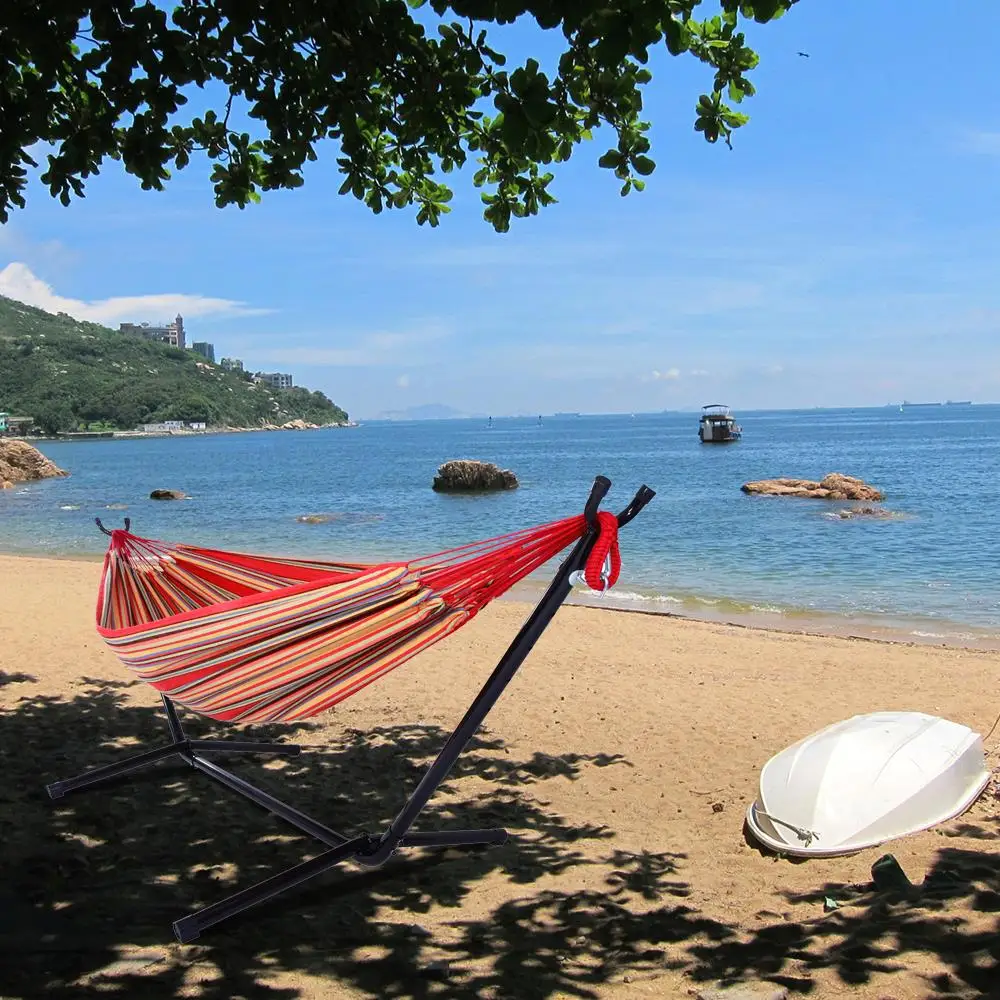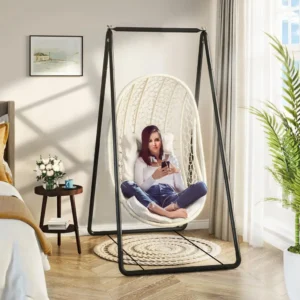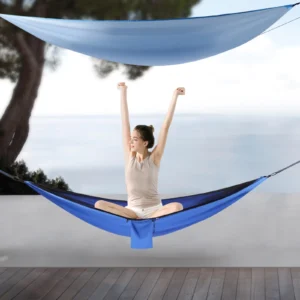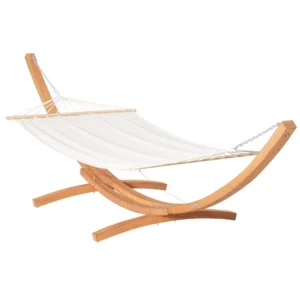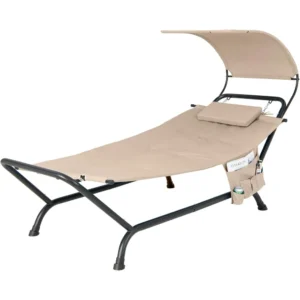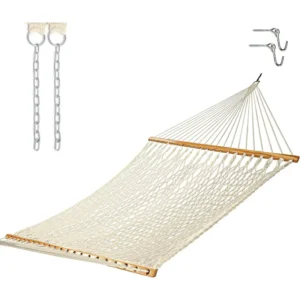Introduction: Understanding the World of Hammocks
Picture yourself gently swaying in the breeze, cocooned in a comfortable hammock as you watch clouds drift overhead or read your favorite book. This simple pleasure represents one of life’s most accessible luxuries—but choosing the right hammock can make all the difference in your relaxation experience.
Today’s hammock enthusiasts face a fundamental choice: portable or fixed? Each option offers distinct advantages depending on your lifestyle, available space, and how you plan to use it. With hammock popularity surging as people seek comfortable outdoor relaxation solutions, understanding these differences becomes increasingly important.
In this comprehensive guide, we’ll explore everything you need to know about both hammock types. Portable hammocks offer freedom and flexibility—designed for travel, camping, and temporary setups. Fixed hammocks provide stability and permanence—creating dedicated relaxation zones in your yard or on your patio.
The perfect hammock for you depends entirely on your personal circumstances, which is why understanding indoor and outdoor hammock placement considerations is so crucial to making the right decision. Let’s dive into the details of each option to help you discover your ideal hammock solution.
Defining the Two Contenders: What Makes Each Unique
A. Portable Hammocks: Freedom in Design
Portable hammocks embody the spirit of adventure and spontaneity. These lightweight, packable options are designed with mobility as their primary feature. Typically crafted from durable yet lightweight synthetic materials like ripstop nylon or polyester, portable hammocks prioritize minimal weight while maintaining strength.
Most portable designs utilize a gathered-end construction where the fabric bunches at either end, connecting to tree straps or other suspension systems. These hammocks typically weigh between 1-2 pounds for ultralight models and can compress to roughly the size of a water bottle when packed—making them ideal companions for hikers, travelers, and adventure seekers.
The setup process usually involves securing suspension straps around anchor points (typically trees) and attaching the hammock ends via carabiners or integrated hooks. The entire process often takes less than three minutes once you’ve developed the skill.
For those seeking versatile relaxation options, portable hammocks with stands provide additional flexibility when suitable trees aren’t available, though at the cost of added weight and complexity.
B. Fixed Hammocks: Permanent Relaxation Stations
Fixed hammocks represent a dedicated commitment to relaxation in a specific location. These semi-permanent or permanent installations emphasize stability, durability, and long-term comfort. Traditional materials like cotton, polyester, or rope constructions predominate, with designs that often incorporate spreader bars to keep the hammock flat and open rather than wrapping around the user.
These hammocks require either permanent mounting points (posts, walls, trees) or specialized stands designed for long-term use. The emphasis shifts from portability to weather resistance, aesthetic appeal, and integration with your outdoor living space.
Fixed hammocks typically offer larger dimensions and higher weight capacities, often supporting 400-600 pounds comfortably. Standard sizes usually measure around 13 feet in length by 55 inches in width, providing ample space for one or even two people to relax.
Quality hammocks with stands eliminate the need for trees or mounting hardware while creating an attractive focal point for your yard, deck, or patio—merging function with design in your outdoor space.
Portable Hammocks: Versatility on the Move
A. Advantages That Make Portable Hammocks Shine
Portable hammocks offer unmatched freedom for the adventurous spirit. Their primary strengths include:
- Ultimate mobility: Pack and carry anywhere your adventures take you
- Versatile setup options: Use in parks, beaches, campsites, or even between city trees
- Minimal storage requirements: Take up virtually no space when not in use
- Cost-effectiveness: Quality options typically range from $20-100
- Quick deployment: Most users can set up in under 3 minutes after practice
- Lightweight design: Many ultralight camping hammock sets weigh less than 2 pounds total
- Adaptability: Use across diverse environments from forests to deserts
- Expandable systems: Add accessories like bug nets, rain flies, or underquilts as needed
The beauty of portable hammocks lies in their spontaneity—spot a perfect pair of trees while hiking, and within minutes you can be relaxing with a view few others will ever experience.
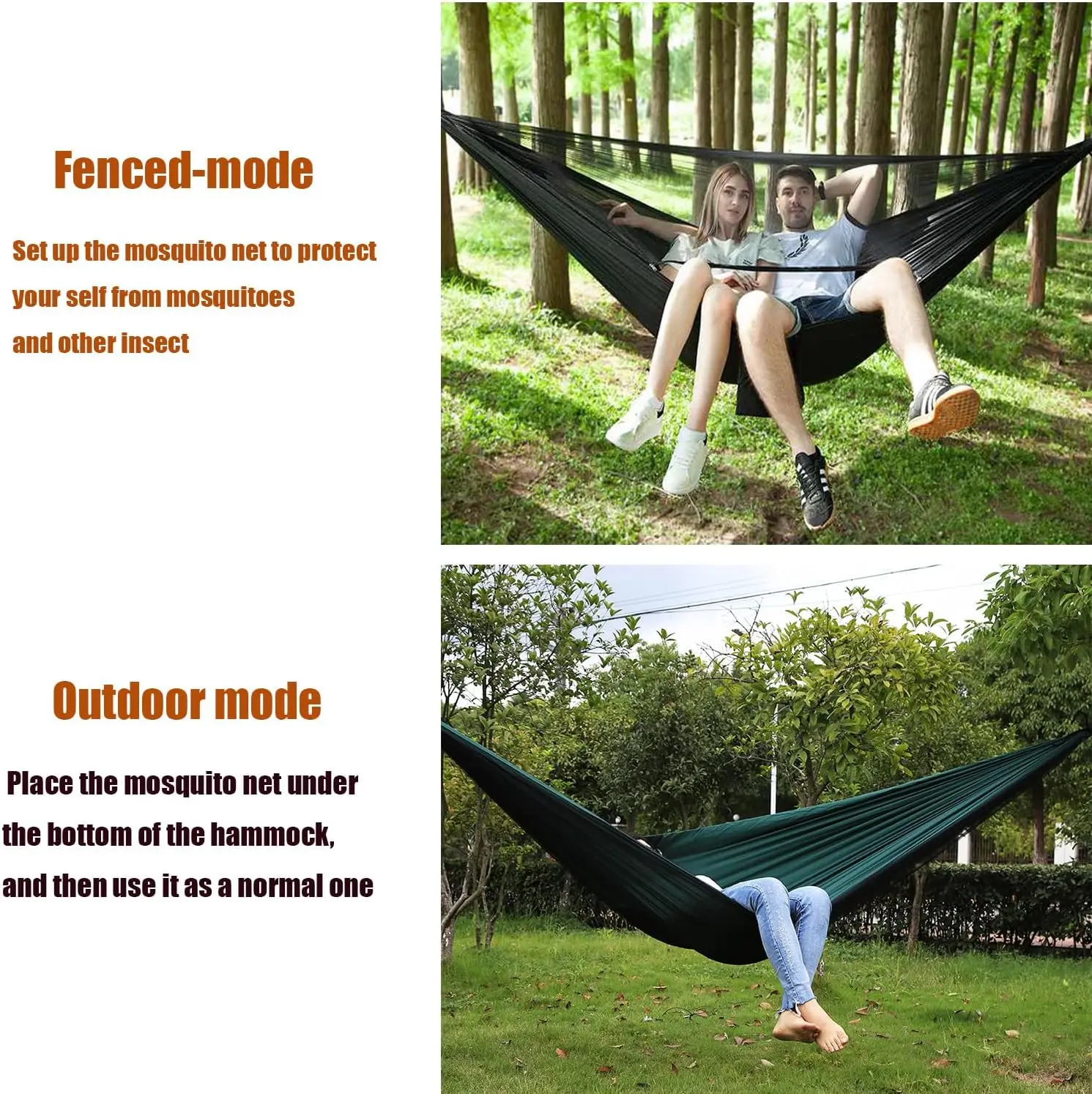
B. Limitations to Consider Before Buying Portable
Despite their versatility, portable hammocks do come with several considerations:
- Dependency on suitable anchor points: Requires appropriately spaced trees or posts
- Size constraints: Generally smaller and potentially less comfortable for extended use
- Durability concerns: Typically last 2-5 years with regular use before showing wear
- Weather vulnerability: Limited protection from elements without additional accessories
- Learning curve: Proper hammock installation requirements and safety knowledge needed for secure setup
- Single-user design: Most portable options accommodate only one person comfortably
- Accessories often required: May need additional purchases for optimal comfort and protection
- Less stable: More movement and potential for tipping compared to fixed options
For weekend warriors and casual users, these limitations may be minor compared to the freedom portable hammocks provide. However, they’re important factors to consider based on your intended use.
Fixed Hammocks: The Dedicated Relaxation Zone
A. Benefits of Choosing a Fixed Hammock
Fixed hammocks transform outdoor spaces into permanent relaxation destinations with several significant advantages:
- Superior stability: Minimal movement for maximum relaxation once properly installed
- Enhanced comfort: Typically featuring thicker materials and more substantial padding
- Impressive durability: Quality options often last 5-10+ years with proper care
- Generous sizing: Many double two-person hammock sets accommodate multiple users
- Aesthetic appeal: Become attractive fixtures that enhance outdoor décor
- Always ready: No setup required when relaxation calls
- Higher weight capacity: Safely support 400-600 pounds depending on design
- Weather resistance: Built with materials designed to withstand outdoor conditions
- Variety of styles: Options range from traditional rope to quilted fabric designs
The permanence of fixed hammocks creates a dedicated relaxation zone that beckons whenever you step outside, becoming an integral part of your outdoor living environment.
B. Drawbacks to Keep in Mind
Fixed hammocks do require certain commitments that may not suit everyone:
- Location commitment: Once installed, they remain in a single place
- Space requirements: Need dedicated area of 12-15 feet plus clearance
- Installation complexity: Often require tools and multiple people for proper setup
- Higher initial investment: Quality options typically cost $100-300+
- Limited portability: Difficult or impossible to relocate or travel with
- Seasonal considerations: May need to understand if it’s okay to leave your hammock outside year-round
- Substantial footprint: Stand options occupy significant space
- Maintenance needs: Regular cleaning and care required for longevity
For those with limited outdoor space or who rent their homes, these factors may present significant obstacles to enjoying a fixed hammock installation.
Head-to-Head Comparison: Making Your Decision Easier
| Feature | Portable Hammocks | Fixed Hammocks |
|---|---|---|
| Weight | 1-2 lbs (ultralight) to 5 lbs | 10-30+ lbs (not including stands) |
| Packed Size | As small as a water bottle | Generally not designed to pack |
| Setup Time | 2-5 minutes | 30+ minutes (initial installation) |
| Price Range | $20-100 | $100-300+ |
| Lifespan | 2-5 years with regular use | 5-10+ years with proper care |
| Weight Capacity | 250-400 lbs typically | 400-600+ lbs typically |
| Comfort Level | Good for short periods | Excellent for extended relaxation |
| Weather Resistance | Limited without accessories | Generally better weatherproofing |
| Space Requirements | Minimal when stored | 12-15 feet plus clearance |
| Versatility | High (usable in multiple locations) | Low (fixed in one spot) |
When analyzing these differences, consider how they align with your lifestyle. Frequent travelers or hikers might prioritize the lightweight nature and versatility of portable options, while homeowners looking to enhance their backyard oasis might prefer the stability and durability of fixed installations.
The ideal hammock should complement your existing routine rather than forcing you to adapt to it. Some enthusiasts who enjoy creating the perfect hammock haven actually end up with both types—portable for adventures and fixed for home relaxation.
Bridging the Gap: Portable Hammocks with Stands
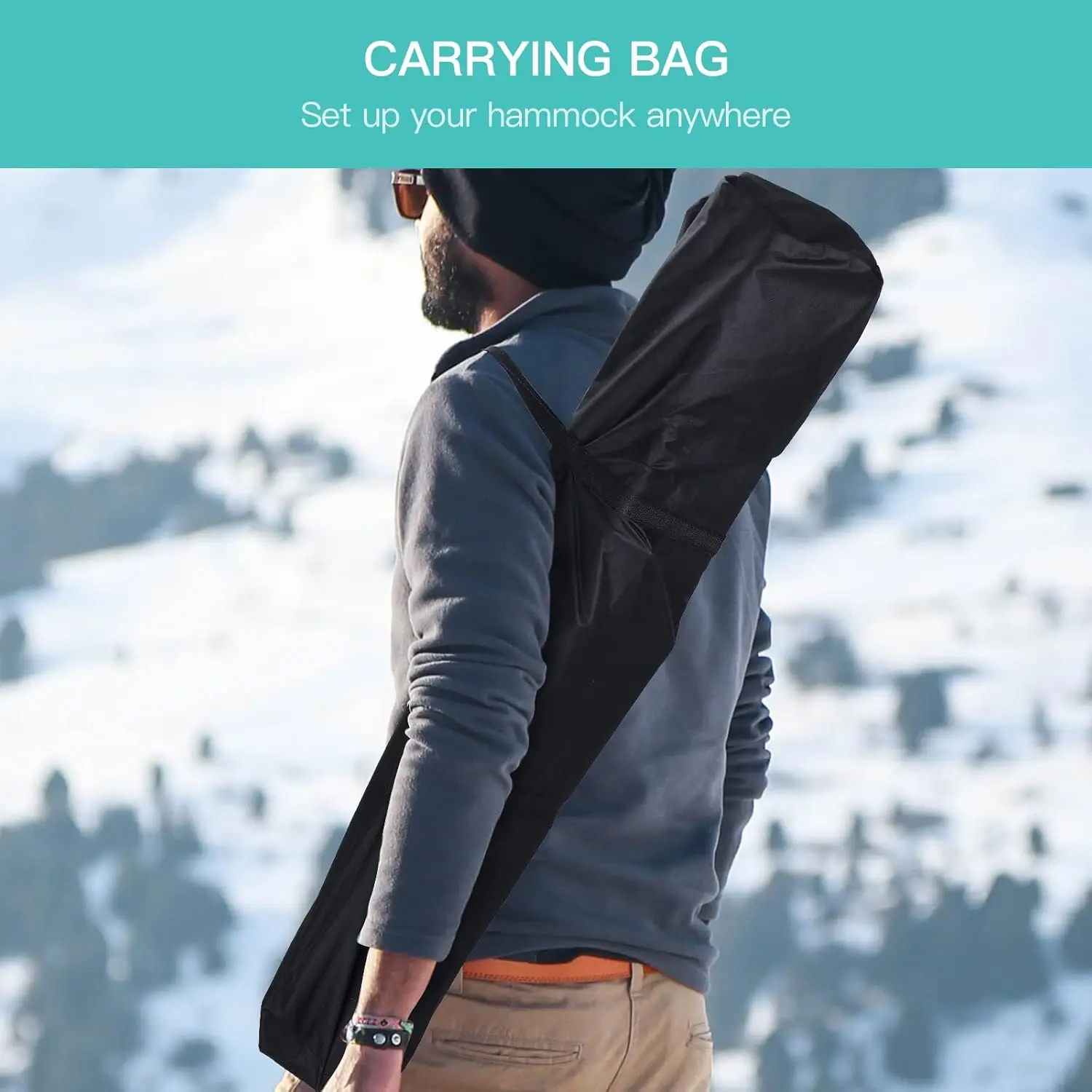
For those caught between the portability of travel hammocks and the stability of fixed options, portable hammock stands offer an elegant compromise. These systems provide the best of both worlds—no trees or mounting hardware required, yet still movable when needed.
Modern folding hammock sets have evolved significantly, offering several advantages:
- No dependency on finding suitable trees or installation points
- Relatively simple setup (typically 5-10 minutes)
- Stability approaching that of fixed installations
- Ability to reposition within your yard or take to other locations
- More consistent setup than tree-hanging methods
- Usable on beaches, fields, or other treeless environments
However, this versatility comes with tradeoffs:
- Heavier than tree-hung portable hammocks (typically 15-25 pounds)
- Bulkier when packed (though many fit in car trunks easily)
- More complex assembly than simple tree straps
- Higher price point than basic portable hammocks
- Less portable than ultralight camping options
These hybrid solutions work particularly well for those who primarily use their hammock at home but occasionally want to bring it to a beach day, camping trip, or visit to friends.
Decision Factors: Finding Your Perfect Match
Choosing between portable and fixed hammocks ultimately comes down to honestly assessing your specific situation. Consider these key factors:
Primary Use Environment
– Will you primarily use it at home or while traveling?
– Do you have suitable trees or mounting points available?
– How much space can you permanently dedicate to relaxation?
Practical Considerations
– How important is setup time and convenience?
– Do you need to store the hammock when not in use?
– Will it be exposed to weather elements regularly?
Personal Preferences
– Do you prioritize ultimate comfort or versatility?
– Is aesthetic appeal an important factor?
– How many people will typically use the hammock at once?
Budget Factors
– What’s your initial budget for the hammock system?
– Are you willing to invest in accessories and weather protection?
– Do you value long-term durability or lower upfront cost?
Understanding the best indoor and outdoor hammock locations for your specific situation can significantly influence which type will provide the most enjoyment. Many hammock enthusiasts find that their needs evolve over time—sometimes starting with a portable option before investing in a fixed installation once they’ve identified their perfect relaxation spot.
Accessorizing Your Hammock: Enhancing the Experience

The right accessories can transform your hammock experience, adapting it to different seasons and environments:
For Portable Hammocks:
– Tree straps for quick, tree-friendly hanging
– Ridgelines for optimal sag adjustment
– Rain flies for weather protection
– Camping hammock sets with bug nets for insect protection
– Underquilts and top quilts for cold-weather comfort
– Gear pockets for organizing essentials
– Drip lines to prevent water running onto hammock during rain
For Fixed Hammocks:
– Decorative pillows for additional comfort
– Weather covers for protection during harsh conditions
– Hammock stands for installation without trees
– Cup holders and side tables for convenience
– Hammock lights for evening ambiance
– Cushioning pads for additional comfort
– Stand hooks for keeping accessories organized
A-Frame Stand Hammock Sets, Swinging Hammock Chair Sets
$154.62 Select options This product has multiple variants. The options may be chosen on the product pageCamping Hammock Sets with Bug Net, Ultralight Camping Hammock Sets
$139.72 Select options This product has multiple variants. The options may be chosen on the product pageClassic Wooden Stand Hammock Sets, Heavy Duty Hammock Sets
$1,061.68 Select options This product has multiple variants. The options may be chosen on the product pageHammock Sets with Canopy, Heavy Duty Hammock Sets
$286.31 Select options This product has multiple variants. The options may be chosen on the product pageDouble / Two Person Hammock Sets, Rope Hammock Sets
Double Traditional Cotton Rope Hammock with Extension Chains – 450 lbs Capacity for Backyard & Patio$292.98 Select options This product has multiple variants. The options may be chosen on the product page
When budgeting for your hammock purchase, consider which accessories might be essential for your intended use. For portable camping hammocks, weather protection and insulation can be just as important as the hammock itself when venturing into variable conditions.
Maintenance and Care: Extending Hammock Lifespan
Proper care significantly extends the life of any hammock, regardless of type:
General Hammock Care Tips:
– Always follow manufacturer cleaning instructions
– Remove dirt and debris regularly
– Allow to dry completely before storage
– Keep away from sharp objects
– Avoid leaving in direct sunlight when not in use
Portable Hammock Maintenance:
– Rinse with fresh water after exposure to salt, sand, or dirt
– Hand wash with mild soap when necessary
– Ensure carabiners and hardware remain free of debris
– Store in provided stuff sack in a cool, dry place
– Regularly inspect suspension components for wear
Fixed Hammock Care:
– Remove during extreme weather when possible
– Clean according to specific material instructions
– Apply fabric protectant to extend weather resistance
– Oil or treat wooden components annually
– Check hardware connections seasonally
– Consider seasonal storage in harsh climates
Understanding proper indoor and outdoor hammock safety not only protects your investment but ensures your relaxation time remains worry-free. With proper care, quality hammocks can provide many years of comfortable relaxation.
Frequently Asked Questions About Hammock Options
Can portable hammocks safely hold two people?
Most portable hammocks are designed for single users with weight limits between 250-400 pounds. Some wider models marketed as doubles can accommodate two average-sized adults, but they’re typically less comfortable than dedicated two-person fixed hammocks. Always check the manufacturer’s weight rating before attempting two-person use.
How do I know if my trees are suitable for hammock hanging?
Ideal trees should be healthy, live hardwoods at least 8 inches in diameter, spaced approximately 12-15 feet apart. Avoid dead trees, thin trees, or those with brittle wood like pines. Always use tree-friendly straps rather than ropes to prevent bark damage.
What’s the minimum space required for a fixed hammock with stand?
Most fixed hammock stands require approximately 15 feet of length and 4-5 feet of width. Additionally, you’ll need clearance space around the hammock for safe entry and exit. Always verify the exact dimensions of your specific stand model before purchasing.
Are portable hammocks comfortable for overnight sleeping?
Many campers and backpackers sleep comfortably in portable hammocks, though proper setup is crucial. Understanding the differences between spreader bar vs gathered end hammocks can significantly impact sleeping comfort. For overnight use, additional accessories like underquilts and bug nets are often necessary for comfortable sleep.
Can I leave my fixed hammock outdoors year-round?
This depends entirely on the hammock material and your local climate. Many weather-resistant hammocks can handle occasional rain, but prolonged exposure to harsh sun, heavy rain, snow, or freezing temperatures will degrade even the most durable materials. When in doubt, store your hammock during extreme weather conditions.
Final Thoughts: Your Journey to Hammock Bliss
Whether you choose the adventurous freedom of a portable hammock or the dedicated comfort of a fixed installation, the perfect hammock ultimately depends on how you plan to use it. Many enthusiasts begin with portable options for their versatility before adding fixed installations to their favorite outdoor spaces as their hammock journey progresses.
Consider starting with the style that best matches your immediate needs—portable for the traveler and adventurer, fixed for the homebody seeking a permanent relaxation destination. Whichever path you choose, the gentle embrace of a well-selected hammock offers one of life’s simple yet profound pleasures—a momentary escape from the hectic pace of everyday life, suspended in perfect comfort.
After all, few experiences rival the sensation of gently swaying in a hammock as you watch the world go by, without a care in the world.

